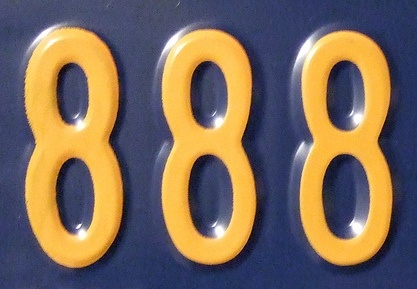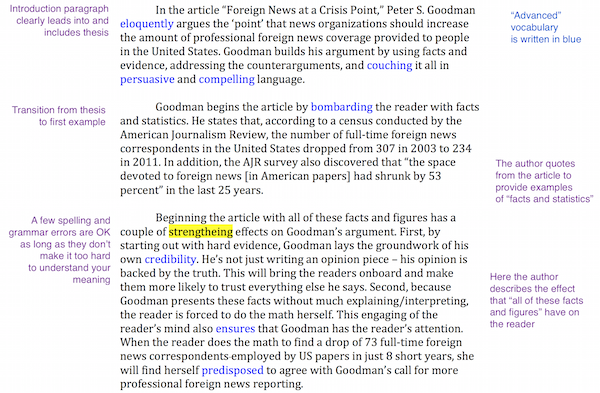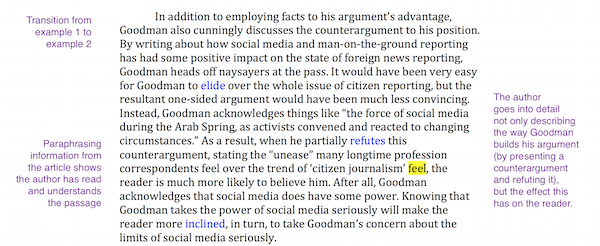
The SAT Essay is scored separately from the rest of the SAT now, thanks to the changes that went into effect in March 2016.
While the essay is now optional (you don't automatically have to take it every time you take the SAT), some colleges still require students to submit SAT essay scores with their applications. Learning how to consistently write a perfect SAT essay will be a huge boost to your application to these schools.
In this article, we'll discuss what it takes to get a perfect 8/8/8 on the SAT essay and what you need to do to train yourself to get this top score.
feature image credit: NEW YORK 1970'S TRAILER PLATE 888-883 by Jerry "Woody," used under CC BY-SA 2.0/Cropped from original.
UPDATE: SAT Essay No Longer Offered
In January 2021, the College Board announced that after June 2021, it would no longer offer the Essay portion of the SAT (except at schools who opt in during School Day Testing). It is now no longer possible to take the SAT Essay, unless your school is one of the small number who choose to offer it during SAT School Day Testing.
While most colleges had already made SAT Essay scores optional, this move by the College Board means no colleges now require the SAT Essay. It will also likely lead to additional college application changes such not looking at essay scores at all for the SAT or ACT, as well as potentially requiring additional writing samples for placement.
What does the end of the SAT Essay mean for your college applications? Check out our article on the College Board's SAT Essay decision for everything you need to know.
The Big Secret
You’ll have to practice this. The perfect SAT essay is like a puzzle that happens to be in written form—it can be mastered, but to do it well and completely every time requires practice with a lot of sample topics. You need to learn the format of an effective essay and how to fill out a complete essay within 50 minutes.
What an SAT Essay Score of 8 Means
If you’re already scoring a 5 or above in all three areas on practice (or real) SAT essays, you have a shot at completely nailing what the graders want, represented by a score of 8/8/8, with a little practice.
But there’s something important to remember in your question for perfection: on the SAT essay, an 8 in all categories is not always achievable. We’ve got good news and bad news for those of you who are determined to score an 8/8/8 on the SAT essay.
 Good News and Bad News by Mike Licht, used under CC BY 2.0/Cropped from original.
Good News and Bad News by Mike Licht, used under CC BY 2.0/Cropped from original.
The Bad News
Because the whole essay task (reading, analyzing, planning, and writing) must be completed in 50 minutes, getting an 8 in Reading, Analysis, and Writing requires some luck.
You have to read the article and analyze the way the author builds her/his argument, pick out the most important components to the argument, find evidence to support your interpretation, and plan out your essay before you can even start writing.
A lot depends on how quickly you can come up with a thesis and relevant support for whatever the prompt happens to be—you might find some articles easier to read and analyze the argumentative structure of than others.
You'll need to use precise language to show mastery of English writing. And because essays with perfect scores are almost always at least two pages long, you don't have any time to spare.
If you trip up on your execution of any of these aspects, the graders might not give your SAT essay an 8/8/8.
The Good News
Because the essay is so formulaic, it's always possible to get a 6 across the board. Sometimes you might find the author's argument to analyze harder than others, or sometimes you might find the article more difficult to get through, but you will always be able to impress them enough to get a 6/6/6.
No college worth its salt is going to base your college admissions decision on getting those last two points on an essay you had 50 minutes to write (especially when the essay is optional). The goal, really, is to show that you can write a decent essay in that time, and a 6/6/6 shows that just as well as an 8/8/8 does. But you should aim as high as you can, so keep reading to find out what it really takes to get a perfect score on the SAT essay.
The Difference Between a 6 and an 8
If we asked the College Board what the difference is between a 6 and an 8 SAT essay, they would direct us to the scoring rubric that shows the criteria for a 1, 2, 3, and 4 in Reading, Analysis, and Writing. (SAT essays are scored by two graders who each rate your essay on a scale of 1-4 in Reading, Analysis, and Writing; the two graders' scores are added together to get scores out of 8 for each domain.)
Below, we've excerpted the criteria for a 3 and a 4 in all three domains and described the differences between the 3 and 4 score levels for Reading, Analysis, and Writing. We’ve marked the differences between the 3 and 4 criteria in bold.
|
|
Proficient: Score of 3 (6) |
Advanced: Score of 4 (8) |
Major Differences |
|
Reading |
The response demonstrates effective comprehension of the source text. The response shows an understanding of the text’s central idea(s) and important details. The response is free of substantive errors of fact and interpretation with regard to the text. The response makes appropriate use of textual evidence (quotations, paraphrases, or both), demonstrating an understanding of the source text. |
The response demonstrates thorough comprehension of the source text. The response shows an understanding of the text’s central idea(s) and of most important details and how they interrelate, demonstrating a comprehensive understanding of the text. The response is free of errors of fact or interpretation with regard to the text. The response makes skillful use of textual evidence (quotations, paraphrases, or both), demonstrating a complete understanding of the source text. |
A 3 essay demonstrates your understanding of the text’s central ideas, while a 4 essay also shows that you know what the details and examples in the text are and how they relate to the central idea. |
|
Analysis |
The response offers an effective analysis of the source text and demonstrates an understanding of the analytical task. The response competently evaluates the author’s use of evidence, reasoning, and/or stylistic and persuasive elements, and/or feature(s) of the student’s own choosing. The response contains relevant and sufficient support for claim(s) or point(s) made. The response focuses primarily on those features of the text that are most relevant to addressing the task. |
The response offers an insightful analysis of the source text and demonstrates a sophisticated understanding of the analytical task. The response offers a thorough, well-considered evaluation of the author’s use of evidence, reasoning, and/or stylistic and persuasive elements, and/or feature(s) of the student’s own choosing. The response contains relevant, sufficient, and strategically chosen support for claim(s) or point(s) made. The response focuses consistently on those features of the text that are most relevant to addressing the task. |
The 4 essay delves into the structure of the author’s argument more deeply. The writer not only states the techniques used in the text, but also thoroughly explains their impact on the reader. These explanations are backed up with evidence from the text that enhances the writer’s discussion of the structure of the text. |
|
Writing |
The response is mostly cohesive and demonstrates effective use and control of language. The response includes a central claim or implicit controlling idea. The response includes an effective introduction and conclusion. The response demonstrates a clear progression of ideas both within paragraphs and throughout the essay. The response has variety in sentence structures. The response demonstrates some precise word choice. The response maintains a formal style and objective tone. The response shows a good control of the conventions of standard written English and is free of significant errors that detract from the quality of writing. |
The response is cohesive and demonstrates a highly effective use and command of language. The response includes a precise central claim. The response includes a skillful introduction and conclusion. The response demonstrates a deliberate and highly effective progression of ideas both within paragraphs and throughout the essay. The response has a wide variety in sentence structures. The response demonstrates a consistent use of precise word choice. The response maintains a formal style and objective tone. The response shows a strong command of the conventions of standard written English and is free or virtually free of errors. |
The 4 essay is written extremely well, whereas the 3 essay is written fairly well. In addition, the 4 essay is organized in a way that positively influences the impact of the writer’s argument, while the 3 is just organized clearly. |
Let’s condense the information above. A perfect 4 essay:
- is extremely clear
- is consistent, smooth, and easy to read
- has few errors
- is not repetitive in content or language
- is sufficiently detailed (using evidence from the text) to fully support the writer’s thesis
- demonstrates that you understand the text and the author’s claim(s)
In other words, you need to excel in every one of these aspects to get a perfect score.
A Sample Essay
Now we’ll look at a sample 8/8/8 SAT essay, and make note of how it fits the criteria above. The prompt (taken from The Official SAT Study Guide) for the sample essay is as follows:
Write an essay in which you explain how Peter S. Goodman builds an argument to persuade his audience that news organizations should increase the amount of professional foreign news coverage provided to people in the United States. In your essay, analyze how Goodman uses one or more of the features listed in the box above (or features of your own choice) to strengthen the logic and persuasiveness of his argument. Be sure that your analysis focuses on the most relevant features of the passage.
The passage to which this prompt refers appears on pp. 183-185 of The Official SAT Study Guide (March 2016 & Beyond), or on slightly different pages in later editions. You'll need the passage to follow along with the sample essay below.
Here’s the essay. Read it first, and we’ll have annotations below.
In the article “Foreign News at a Crisis Point,” Peter S. Goodman eloquently argues the ‘point’ that news organizations should increase the amount of professional foreign news coverage provided to people in the United States. Goodman builds his argument by using facts and evidence, addressing the counterarguments, and couching it all in persuasive and compelling language.
Goodman begins the article by bombarding the reader with facts and statistics. He states that, according to a census conducted by the American Journalism Review, the number of full-time foreign news correspondents in the United States dropped from 307 in 2003 to 234 in 2011. In addition, the AJR survey also discovered that “the space devoted to foreign news [in American papers] had shrunk by 53 percent” in the last 25 years.
Beginning the article with all of these facts and figures has a couple of strengtheing effects on Goodman’s argument. First, by starting out with hard evidence, Goodman lays the groundwork of his own credibility. He’s not just writing an opinion piece—his opinion is backed by the truth. This will bring the readers onboard and make them more likely to trust everything else he says. Second, because Goodman presents these facts without much explaining/interpreting, the reader is forced to do the math herself. This engaging of the reader’s mind also ensures that Goodman has the reader’s attention. When the reader does the math to find a drop of 73 full-time foreign news correspondents employed by US papers in just 8 short years, she will find herself predisposed to agree with Goodman’s call for more professional foreign news reporting.
In addition to employing facts to his argument’s advantage, Goodman also cunningly discusses the counterargument to his position. By writing about how social media and man-on-the-ground reporting has had some positive impact on the state of foreign news reporting, Goodman heads off naysayers at the pass. It would have been very easy for Goodman to elide over the whole issue of citizen reporting, but the resultant one-sided argument would have been much less convincing. Instead, Goodman acknowledges things like “the force of social media during the Arab Spring, as activists convened and reacted to changing circumstances.” As a result, when he partially refutes this counterargument, stating the “unease” many longtime profession correspondents feel over the trend of ‘citizen journalism’ feel, the reader is much more likely to believe him. After all, Goodman acknowledges that social media does have some power. Knowing that Goodman takes the power of social media seriously will make the reader more inclined, in turn, to take Goodman’s concern about the limits of social media seriously.
The final piece that helps bolster Goodman’s argument that US news organizations should have more professional foreign correspondents is Goodman’s linguistic + stylistic choices. Goodman uses contrasts to draw the reader deeper into his mindset. By setting up the contrast between professional reporters as “informational filters” that discriminate good from bad and amateur, man-on-the-spot reporters as undiscriminating “funnels,” Goodman forces the reader to view the two in opposition and admit that professional filters are to be preferred over funnels that add “speculatio, propaganda, and other white noise” to their reporting. In addition, Goodman drives the reader along toward agreeing with his conclusion in the penultimate paragraph of the article with the repetition of the phrase “We need.” With every repetition, Goodman hammers even further home the inescapable rightness of his argument. The use of “We” more generally through the article serves to make the readers feel sympathetic towards Goodman and identify with him.
By employing the rhetorical techniques of presenting facts, acknowledging the other side, and using persuasive language, Goodman convinces the reader of his claim.
Here are our notes on what stands out in this essay (general comments are in purple, spelling/grammar errors are highlighted in yellow):



Note that not every 8/8/8 essay needs to have exactly the same items in here, nor do you need to argue in exactly the same way. But the elements in this essay make it a standout and demonstrate clear mastery.
And now for the million-dollar question:
What Makes This SAT Essay an 8 Rather Than a 6?
Maybe you get the theory behind what makes an essay an 8/8/8, but how can you tell the difference between a 6 and an 8 in practice? Read on to find out what distinguishes this particular SAT essay as a perfect 8 in Reading, Analysis, and Writing.
Precise Language
SAT graders are big on clarity, and clarity requires precise language and obvious, sound logic. In this essay, vivid language is used effectively and appropriately:
- Goodman is described as bombarding the reader with facts and figures
- The writer describes Goodman as arguing his point using not just language but persuasive and compelling language:
- The effect of Goodman’s argument is not just that it convinces the reader, but that "the reader…will find herself predisposed to agree with Goodman’s call for more professional foreign news reporting."
All of this clear and precise language helps support and explain the author's point (just as Goodman’s language supports his point in the text!).
Effective Analysis and Organization
The writer's clarity extends to her logic as well. Sufficient background is given to make it clear the writer read and understood the text. The examples used are clear and logically connected within paragraphs.
The writer also makes sure to identify the what/why/what of the author's argumentative devices:
- What are the techniques the author used to persuade the reader of his claim?
- Why did the author use them?
- What effect does their use have on the reader?
The organization of the essay follows the organization set out in the introduction: the writer first discusses facts and evidence, then the presentation and refutation of a counterargument, then compelling language. Organization in the essay is aided by transitions between all paragraphs, which create a smooth, consistent argument that is easy to follow.
Consistency Throughout
The clarity of the argument and the lack of errors remain consistent from start to finish. The highlighted errors are few and do not detract or distract from the meaning of the essay. The wording of the thesis statement in the introduction and the conclusion is similar but not identical, and the description of how Goodman builds his argument is the same.
 Dos piezas by Raúl Hernández González, used under CC BY 2.0/Cropped from original.
Dos piezas by Raúl Hernández González, used under CC BY 2.0/Cropped from original.
Variety
The author uses a variety of words (marked in blue) and sentence structures to convey similar ideas in different ways throughout the essay. For instance, social media, man-on-the-ground (or man-on-the-spot) reporting, citizen journalism, and amateur reporting are all different words and phrases used to describe the same phenomenon of non-professional foreign news correspondents.
In paragraph 4, there's also a good example of a skillfully executed variation in sentence structure. “Knowing that Goodman takes the power of social media seriously will make the reader more inclined…” could easily be the simpler “Goodman takes the power of social media seriously, which makes the reader more likely to agree…” This kind of linguistic "flourish" can be found in most top-scoring SAT Essays.
Note that all of the varied usage described above is effective as well as varied. SAT vocab words and differening sentence structures aren't thrown into the essay haphazardly—it's clear, effective writing like what you might read in the New York Times.
Detailed Support and Length
The essay is long enough to detail three complex examples (discussing Goodman’s use of facts and evidence, a counterargument, and vivid language) and include introductory and concluding paragraphs.
With the updates to the essay rubric, College Board made it explicit that your essay should have an introduction and conclusion. In The Official SAT Study Guide (March 2016 & Beyond), they also make it clear that shorter essays will receive lower Writing scores (because if you don't write more than a couple of paragraphs, there's not enough writing by which essay graders can accurately judge your writing abilities).
But length means nothing if there isn't valuable information filling the space, so long SAT essays also need to be detailed—this author uses the space to give lots of context for her examples.
Dos and Don’ts for an 8/8/8 SAT Essay
The key for a perfect score on the SAT essay is to use your time wisely and stay focused on the task. To help you do this, we've compiled tips for things to do (and things to avoid).
Do spend time:
- Writing as much as you can without including repetitive or irrelevant information.
- Revising the first and last paragraphs (they stand out in readers’ minds).
- Making sure you have effective transitions for a seamless essay.
- Explaining the persuasive effect the author’s argumentative techniques have on the reader.
Don't spend time:
- Thinking of “smart-sounding" evidence—analysis of how the author used a personal anecdote is just as viable as a discussion of the author’s use of logos and other rhetorical strategies.
- Trying to correct every single error—the grammar and the spelling do not have to be perfect to score an 8 in Writing. This doesn't mean that you should just leave sentence fragments all over the place, but it does mean that accidentally leaving off the last letter of a word or making a small subject/verb agreement error won't be the end of the world (or of your perfect SAT essay score). Spend the extra time trying to write more and develop your points.
- Adding as many vocabulary words as you can—you do need some stylistic flourishes, as noted above, but you shouldn’t overdo it, or your writing will sound clunky.
How to Train to Improve Your SAT Essay Score
As I mentioned above, most anyone can train to reliably get a 6 on all sections of the essay, and many can move beyond that to consistently get 8/6/6, 6/6/8, or 8/8/8. Here’s a framework for how to do this:
- Read through our complete list of SAT essay prompts.
- Memorize a list of persuasive techniques that you can find in most essay prompt articles.
- Start by practicing with extended time (80 minutes) so you can feel what it takes to get a top-scoring essay. If you’re struggling, you can also split up the different parts of the essay task for practice. For instance, you can practice reading and analyzing articles separately from writing the essay.
- Find a way to grade your essay. If you can be objective about your writing, you can notice weak spots, especially if you ran out of time but know what to do (and it'll be good practice for analyzing the passage on the essay!). Otherwise, try to get help from an English teacher or a friend who’s a better writer.
- Start narrowing your essay time down to 50 minutes to mirror the actual test.
What’s Next?
Ready to get started with practice essays? Check out our thorough analysis of the SAT essay prompt and our complete list of prompts to practice with.
Use our 15 tips to improve your SAT essay score.
Follow along as I take you through how to write a top-scoring SAT essay, step by step.
Took the old SAT essay and want to know what's changed? Read our complete guide to the March 2016 SAT essay here.












